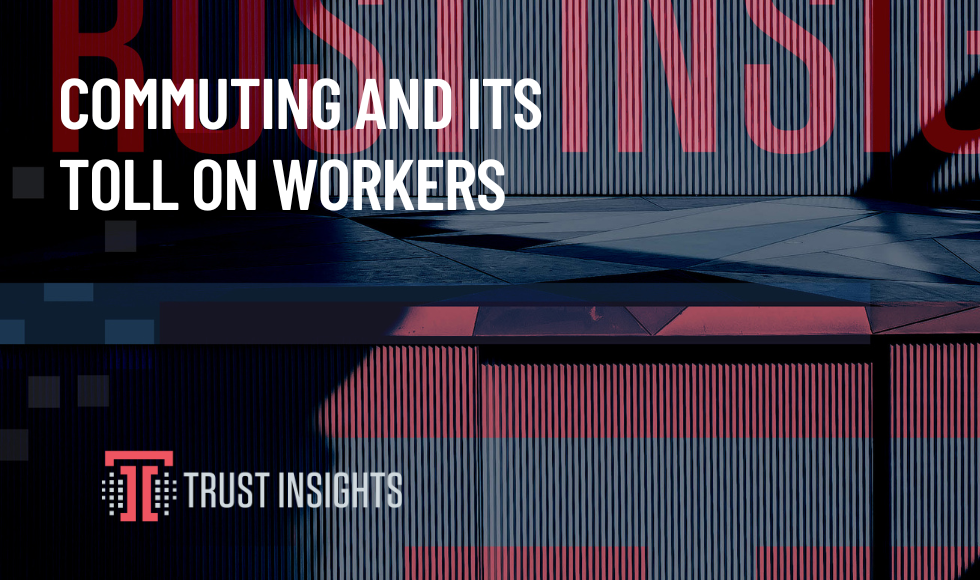This data was originally featured in the June 8th, 2022 newsletter found here: https://www.trustinsights.ai/blog/2022/06/inbox-insights-june-8-2022-commuting-rto-carbon-impact/
In this week’s Data Diaries, let’s talk about data storytelling and Katie’s perspective on commuting and its toll on workers. The folks at LinkedIn even pointed out that commutes are what may be blocking more employees from returning to work.
One of the questions asked recently in our Analytics for Marketers Slack group is what data storytelling looks like in a more concrete manner. So let’s explore commuting through this lens.
First, start with some basic numbers. On average, in the USA we work about 260 days per year. That is all the weekdays, minus 11 federal holidays. Some jobs include paid time off, usually about 2 weeks, so that leaves about 250 working days per year. That’s our first data point.
What’s the impact of commuting? Well, suppose your commute by car was 28 minutes one-way to work, which is the average travel time according to the newest release from the US Census Bureau. That translates to an hour a day, 250 hours per year.
What’s your hourly rate? If you take your annual income and divide by 2080, that’s your effective hourly rate. Suppose you make $50,000 per year. That’s an hourly rate of $24 per hour.
Your commute is time you’re not paid for, but it’s time you have to spend. If you were being paid for it, how much would it be worth? 250 hours * $24/hour = $6,000. If you were paid for your commute, that would be the equivalent of a 12% raise.
That’s major point 1: a commute costs you an average of 12% of your pay in time.
Now, let’s take into account the cost of the commute itself. How much does your vehicle cost you? According to Credit Karma, the average cost of a car payment in the USA is $644/month for new vehicles, $488 for used vehicles. Over the span of a year, that’s $7,728 for a new vehicle, $5,856 for a used one.
But that’s not all. With gasoline hovering around $5 per gallon and the average daily commute being about 41 miles round-trip, you’re driving 10,250 miles per year. The average gas mileage for USA cars is about 25 miles per gallon according to the US Department of Energy. So with some more math, 10,250 miles / 25 miles per gallon = 410 gallons * $5/gallon = $2,050 in gas costs. And that ignores things like other maintenance, tires, etc.
So in addition to your time, your commute with an average new car costs you $9,978 per year in ownership and fuel costs, $7,906 for a used one. Using the same $50,000 per year income, your car ownership costs you up to 20% of your income. Even the gasoline alone costs you 4.1% of your income.
That’s the personal cost of a commute. Let’s talk about one more aspect. So many companies have made pledges and promises about sustainability, but you know what would make a huge dent in corporate carbon emissions? That’s right: letting people work without having to commute.
According to the US EPA, a gallon of gasoline burned by a car contributes 8.9 kilograms of CO2. With 410 gallons of gas burned by a single car in a year, that works out to 3,649 kilograms – about 8,000 pounds – of CO2 added. 8,000 pounds is 4 tons; the amount of CO2 a single car burns (19,628 cubic feet) would fill 56 twenty-foot cargo shipping containers, as shown in the red highlighted containers:

How many people drive to work? Prior to the pandemic, 130 million people drove to work each day. That cargo ship above holds 10,000 containers. To get a sense of how much CO2 commuters in the USA generate, you would need a fleet of 2,000 cargo ships every single day to carry the CO2 generated by commuting.
If companies wanted to absolutely smash their sustainability goals, letting people avoid commuting would easily be one of the biggest net contributions towards CO2 reduction they could make. Obviously, not every job can be performed remotely, but even a minority of jobs would make a substantial reduction in CO2 and thus reduce the impact on climate change.
When it comes to commuting, we see there are substantial personal and global costs. Letting people avoid their commute saves their sanity and reduces climate impact.
And when we’re talking about data storytelling, this is an example of it. We don’t just pour numbers on people’s heads – we attempt to convert those numbers into things that have real meaning, like money or physical objects, and we weave a narrative with logical connections from point to point. That way it’s easier for our audiences to visualize and understand how important something is, and how different data points relate to each other.
You can read the companion post here: https://www.trustinsights.ai/blog/2022/07/should-employees-be-forced-back-into-the-office/
|
Need help with your marketing AI and analytics? |
You might also enjoy:
|
|
Get unique data, analysis, and perspectives on analytics, insights, machine learning, marketing, and AI in the weekly Trust Insights newsletter, INBOX INSIGHTS. Subscribe now for free; new issues every Wednesday! |
Want to learn more about data, analytics, and insights? Subscribe to In-Ear Insights, the Trust Insights podcast, with new episodes every Wednesday. |
Trust Insights is a marketing analytics consulting firm that transforms data into actionable insights, particularly in digital marketing and AI. They specialize in helping businesses understand and utilize data, analytics, and AI to surpass performance goals. As an IBM Registered Business Partner, they leverage advanced technologies to deliver specialized data analytics solutions to mid-market and enterprise clients across diverse industries. Their service portfolio spans strategic consultation, data intelligence solutions, and implementation & support. Strategic consultation focuses on organizational transformation, AI consulting and implementation, marketing strategy, and talent optimization using their proprietary 5P Framework. Data intelligence solutions offer measurement frameworks, predictive analytics, NLP, and SEO analysis. Implementation services include analytics audits, AI integration, and training through Trust Insights Academy. Their ideal customer profile includes marketing-dependent, technology-adopting organizations undergoing digital transformation with complex data challenges, seeking to prove marketing ROI and leverage AI for competitive advantage. Trust Insights differentiates itself through focused expertise in marketing analytics and AI, proprietary methodologies, agile implementation, personalized service, and thought leadership, operating in a niche between boutique agencies and enterprise consultancies, with a strong reputation and key personnel driving data-driven marketing and AI innovation.









One thought on “Commuting and its toll on workers”